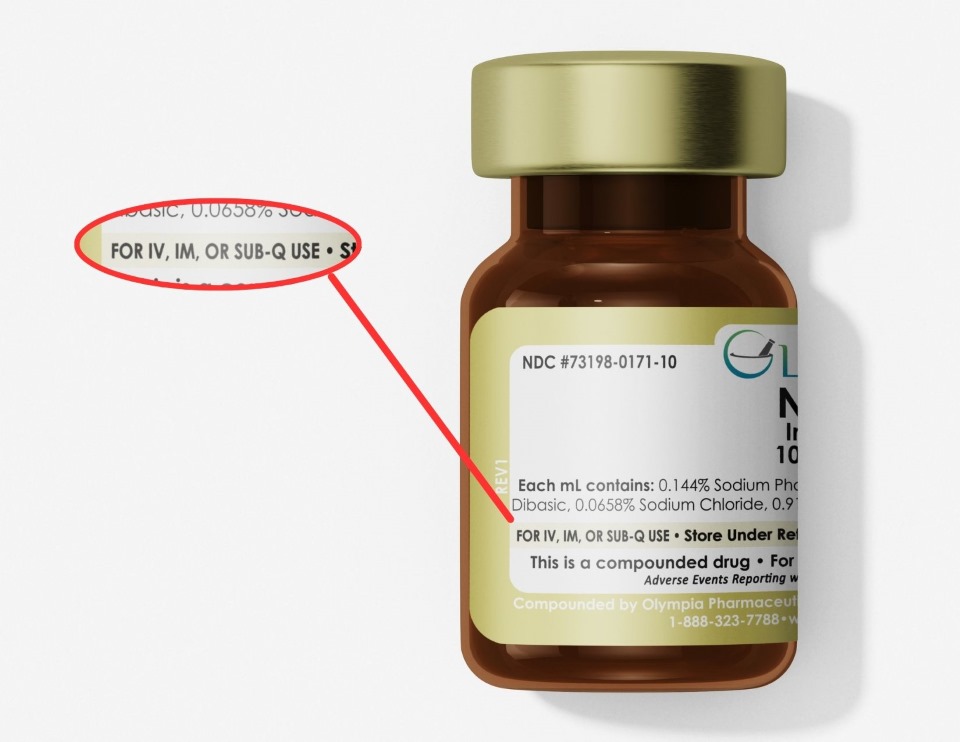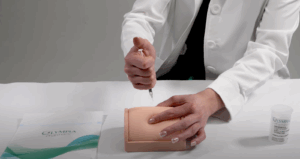Learning how to give yourself a subcutaneous (SubQ) injection can feel intimidating at first, but with proper preparation and guidance from your provider, it can become a straightforward part of your wellness routine. SubQ injections deliver medication into the fatty layer between the skin and muscle, allowing for gradual absorption.
Before you begin the process, always review your prescription label carefully and confirm that your medication is intended for subcutaneous use. Never inject any medication unless directed by a licensed healthcare provider.

What You’ll Need Before You Begin
✔ Medication vial with prescription label.
✔ Alcohol swabs. These help sanitize both the injection site and rubber stopper of your vial.
✔ U-100 insulin syringe. The preferred needle for subcutaneous injections. These are single-use needles that must be disposed of after an injection.
✔ Sharps container for needle disposal. These can be purchased at your local pharmacy. If you do not have one available, a heavy-duty plastic container such as an empty laundry detergent bottle can be used. Just ensure the container is empty, clean, and the lid screws on tightly.
Before You Begin:
- Inspect your medication upon arrival for clarity and expiration date.
- Read the vial label carefully. Some medications must be stored refrigerated, while others can be stored at room temperature. Double check that the medication can be administered subcutaneously.
- If anything looks unusual, or if you have questions, contact your medical provider or Olympia Pharmaceuticals before use.
Step-by-Step: How to Give a Subcutaneous Injection
Step 1: Choose an Injection Site
You can inject subcutaneously in one of three areas:
✔ Upper Arm: back of the arm, halfway between shoulder and elbow
✔ Abdomen: below the ribs, above the hip bones, and at least 2 inches from the navel
✔ Thigh: upper outer area of the front thigh
Rotate injection sites each time to avoid irritation.

Step 2: Prepare the Medication
- Remove the foil seal from the vial (if it’s your first use).
- Wipe the rubber stopper with a new alcohol swab.
- Attach a fresh needle to your syringe if it’s not pre-attached.
Step 3: Load the Syringe
- Puncture the vial stopper and draw up the prescribed dose.
- Keep the vial upright at a 90-degree angle.
- Use the top edge of the plunger stopper to measure accurately (e.g., 10 units = 0.1 mL).
Step 4: Clean and Pinch the Skin
- Sanitize the chosen injection site with a clean alcohol swab.
- Let the area dry.
- With your non-dominant hand, gently pinch 1–2 inches of skin.

Step 5: Inject the Medication
- Hold the syringe like a pencil.
- Insert the needle at a 90-degree angle in one steady motion (use 45° if you can only pinch 1 inch of skin).
- Push the plunger slowly to deliver the full dose.
Step 6: Remove and Dispose
- Withdraw the needle gently.
- Place it immediately into a sharps container — never household trash.
- Apply light pressure with gauze if bleeding occurs.
- Massage the area lightly. This helps with the absorption of the medication into the tissue.
Storage & Preparation Tips
- Storage Conditions: Always follow the vial label for proper storage instructions, Some medications may require refrigeration or protection from light.
- Needle Size: U-100 insulin syringes with short, thin needles are ideal for SubQ injections. If you are uncertain, check with your medical provider.
- Avoid Reuse: Always use a new syringe and needle for every injection.
- Timing: Some medications are administered daily, while others may require weekly injections. Follow your prescriber’s plan.
5 SubQ Injections You Might Give at Home
Once you’ve learned the proper technique, you may find that your provider has prescribed one of several medications for SubQ injection. Here are a few examples commonly dispensed by Olympia.
1) NAD+
Nicotinamide adenine dinucleotide, also known as NAD+, NAD plus or an NAD injection, is a coenzyme involved in energy metabolism and DNA support. When compounded as an injection, Olympia’s NAD+ is often prescribed for subcutaneous use.
2) Sermorelin
A peptide that stimulates growth-hormone release, sermorelin is often prescribed for subcutaneous administration and used under medical supervision in wellness and body composition programs.
3) Glutathione
A tripeptide antioxidant, Glutathione may be prescribed in IM or SubQ form based on patient protocol.
4) MICC (Methionine, Inositol, Choline, Cyanocobalamin)
A compounded lipotropic blend that contains vitamin B12. MICC is typically IM, though standalone B12 is approved for SubQ or IM routes. Always follow your provider’s direction.
5) NAD+ & Sermorelin Combo
A combination used in Olympia’s Longevity line. The NAD injection may support cellular energy while sermorelin stimulates natural growth-hormone release.
Safety & Disposal Reminders
- Never reuse needles or syringes. Doing so may result in contamination, infections, or other serious health complications.
- Ensure your sharps container remains out of reach of children and pets.
- Follow your state’s disposal program or visit https://safe.pharmacy/drug-disposal/ to locate a drug disposal box near you.
- Always check your label for specific instructions before each dose.
This content is for educational purposes only and is not a substitute for advice from a licensed medical provider. All compounded formulations are prepared by Olympia Pharmaceuticals under cGMP practices and with oversight by national and state pharmacy boards.

